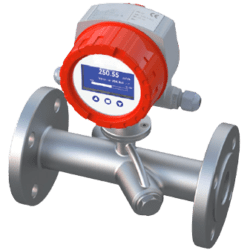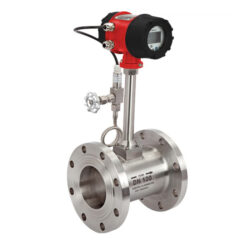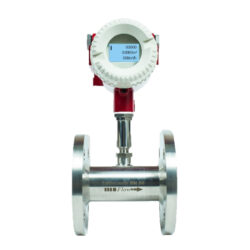Description
An electromagnetic flow meter is a type of flow meter that uses Faraday’s law of electromagnetic induction to measure the flow rate of a conductive fluid. It operates based on the principle that when a conductive fluid flows through a magnetic field, a voltage is induced across the fluid that is proportional to the velocity of the fluid.
An electromagnetic flow meter consists of a flow tube made of a non-magnetic material such as plastic or ceramic, with two electrodes mounted on opposite sides of the tube. A magnetic field is generated perpendicular to the flow tube, and when a conductive fluid flows through the tube, the voltage induced across the electrodes is proportional to the flow rate of the fluid.
The advantages of electromagnetic flow meters include their high accuracy, their ability to measure flow rates in both liquids and gases, their ability to handle corrosive and abrasive fluids, and their ability to measure bidirectional flow. They are commonly used in industries such as water and wastewater treatment, chemical and petrochemical, and food and beverage.
However, electromagnetic flow meters may not be suitable for applications where the fluid is non-conductive or has a low conductivity, such as oils or hydrocarbons. Additionally, they may require periodic calibration to maintain their accuracy, and their accuracy may be affected by changes in fluid temperature and conductivity.
As applied to the design of magnetic flow meters, Faraday’s Law indicates that signal voltage (E) is dependent on the average liquid velocity (V) the magnetic field strength (B), and the length of the conductor (D) (which in this instance is the distance between the electrodes).
Also, In the case of a wafer-style Electromagnetic flow meter, a magnetic field is established throughout the entire cross-section of the flow tube. If this magnetic field is considered the measuring element of the magnetic flow meter, it can be seen that the measuring element is exposed to the hydraulic conditions throughout the entire cross-section of the flow meter. With insertion-style flow meters, the magnetic field radiates outward from the inserted probe.
An electromagnetic flow meter, also known as a magnetic flow meter or mag meter, is a type of device used to measure the flow rate of electrically conductive fluids, such as water or wastewater. It operates based on the principle of Faraday’s Law of Electromagnetic Induction, which states that a voltage is induced in a conductive fluid when it moves through a magnetic field. This voltage is proportional to the velocity of the fluid, allowing for accurate flow rate measurements.
The basic components of an electromagnetic flow meter include a flow tube, an excitation coil, and two sensing electrodes. The flow tube is typically made of non-magnetic material, such as stainless steel, or lined with a non-conductive material to prevent corrosion. It has a circular cross-section to ensure uniform flow distribution and minimize pressure drop.
The excitation coil is wound around the flow tube and generates a magnetic field when an electric current passes through it. This magnetic field is perpendicular to the fluid flow direction and interacts with the conductive fluid. As the fluid flows through the magnetic field, it induces a voltage in the fluid proportional to its velocity.
The sensing electrodes are located on opposite sides of the flow tube, perpendicular to the magnetic field. They are in contact with the fluid and provide a path for the induced voltage to be detected. The voltage between the electrodes is proportional to the fluid velocity and is measured by the flow meter’s electronics.
To ensure accurate measurements, various factors need to be considered. The flow meter must be calibrated for the specific fluid being measured, taking into account its conductivity and temperature. The flow tube diameter should also be selected based on the expected flow rates, ensuring that the flow velocity remains within a suitable range for accurate measurements.
Electromagnetic flow meters offer several advantages over other flow measurement technologies. They do not have any moving parts, reducing the risk of wear and tear and minimizing maintenance requirements. Additionally, they can measure a wide range of flow rates, from low to very high velocities. The accuracy of electromagnetic flow meters is also relatively high, typically within ±0.5 to 1% of the actual flow rate. They are also unaffected by changes in fluid density, viscosity, or temperature, making them suitable for various applications.
There are, however, some limitations to consider when using electromagnetic flow meters. They require a conductive fluid to operate correctly, meaning non-conductive or non-ferrous fluids cannot be measured accurately. Additionally, the presence of air bubbles, foam, or solids in the fluid can affect the measurements and may require additional precautions, such as the use of straight pipe sections or flow conditioning devices.
In recent years, advancements in technology have led to the development of more sophisticated electromagnetic flow meters. These include features such as digital signal processing, self-diagnostic capabilities, and improved resistance to noise and electrical interference. These advancements have further improved the accuracy and reliability of electromagnetic flow meters in various industrial, municipal, and commercial applications.
In conclusion, an electromagnetic flow meter is a valuable tool for measuring the flow rate of electrically conductive fluids. It relies on the principles of electromagnetic induction to provide accurate and reliable measurements without any moving parts. With ongoing technological advancements, electromagnetic flow meters continue to be widely used in diverse industries for the monitoring and control of fluid flow.
One important aspect is the selection of the appropriate liner material for the flow tube. Since electromagnetic flow meters are often used for measuring corrosive or abrasive fluids, the flow tube should be lined with a material that can resist such conditions. Common liner materials include polytetrafluoroethylene (PTFE), perfluoroalkoxy (PFA), rubber, and various types of ceramics. The choice of liner material depends on the specific application and the properties of the fluid being measured.
Another consideration is the installation orientation of the flow meter. Electromagnetic flow meters are typically installed in a horizontal, vertical, or inclined pipe section. The installation orientation can impact the accuracy of the measurements. For example, air bubbles or gas pockets may accumulate at high points in a vertical installation, potentially affecting the flow rate readings. It is crucial to follow the manufacturer’s guidelines and recommendations for proper installation.
Calibration is fundamental to ensuring accurate measurements. Electromagnetic flow meters usually require calibration to account for deviations or variations caused by factors such as fluid conductivity changes, temperature fluctuations, or electrode aging. Calibration can be performed in situ using reference flow meters or by using laboratory calibration facilities, depending on the specific requirements.
Additionally, electromagnetic flow meters may incorporate various features and technologies to enhance their functionality and reliability. For instance, some models employ digital signal processing algorithms to filter out noise and interference, improving the signal-to-noise ratio and accuracy of the measurements. Others may include self-diagnostic capabilities to detect issues such as electrode coating or faulty electronics and provide alerts or alarms for maintenance or troubleshooting purposes.
Overall, electromagnetic flow meters are widely used in industries such as water and wastewater management, chemical processing, pharmaceuticals, food and beverage, and many others. Their accuracy, reliability, and ability to handle a broad range of flow rates and fluid conditions make them a popular choice for flow measurement in various applications.
Electromagnetic flow meters find applications in a wide range of industries. Some key industries where electromagnetic flow meters are commonly used include:
Water and Wastewater Management
Electromagnetic flow meters are extensively used in water treatment plants, wastewater treatment facilities, and distribution networks to measure the flow rate of water and wastewater. They play a crucial role in monitoring and managing water resources, ensuring efficient process control, and detecting leaks or abnormalities in the system.
Chemical Processing
In chemical plants, electromagnetic flow meters are employed to measure the flow rates of various chemicals, acids, bases, and solvents. They enable precise control over the dosing and mixing processes, ensuring accurate ingredient proportions and facilitating quality control.
Pharmaceuticals
In pharmaceutical manufacturing, electromagnetic flow meters are used for measuring the flow rates of liquids used in drug formulation, production, and packaging. They help in maintaining batch consistency, controlling flow rates during production, and ensuring accurate filling of containers.
Food and Beverage
Electromagnetic flow meters are widely used in the food and beverage industry to measure the flow rates of liquids such as juice, milk, beer, wine, and other ingredients. They are crucial for maintaining accurate portioning, ensuring product quality, and monitoring production processes.
Oil and Gas
In the oil and gas industry, electromagnetic flow meters are utilized for measuring the flow rates of various fluids, including crude oil, refined petroleum products, natural gas, and water used in extraction, refining, and transportation processes. They aid in process optimization, custody transfer applications, and monitoring pipeline integrity.
Mining
Electromagnetic flow meters are employed in the mining industry to measure and monitor the flow rates of slurries, tailings, and various process liquids. They play a role in process control, optimizing mineral extraction, and managing water usage in mining operations.
Power Generation
In power plants, electromagnetic flow meters are used to measure the flow rates of cooling water, condensate, fuel, and other fluids involved in power generation processes. They assist in efficient heat transfer, water treatment, and fuel consumption monitoring.
HVAC and Building Automation
Electromagnetic flow meters are employed in heating, ventilation, and air conditioning (HVAC) systems to measure the flow rates of water and other heat transfer media. They contribute to energy efficiency and effective temperature control in buildings and commercial facilities.
These are just a few examples of the industries where electromagnetic flow meters are widely used. Their versatility, accuracy, and robustness make them suitable for various other industries where flow rate measurements are indispensable for process control, energy management, and resource optimization.
Advantages of Electromagnetic Flow Meters
Accurate and Reliable
Electromagnetic flow meters offer high accuracy, typically within ±0.5% to 1% of the actual flow rate. They provide reliable measurements even in challenging fluid conditions or varying flow rates.
Wide Flow Range
Electromagnetic flow meters can measure a wide range of flow rates, from low to very high velocities. This versatility makes them suitable for a variety of applications.
No Moving Parts
Since electromagnetic flow meters do not contain any moving parts, they have low maintenance requirements and are less prone to wear and tear. This increases their longevity and reduces the need for frequent servicing.
Unaffected by Fluid Properties
Electromagnetic flow meters are not significantly affected by changes in fluid density, viscosity, or temperature. They provide accurate measurements regardless of the fluid characteristics or variations.
Suitable for Conductive Fluids
These flow meters work with electrically conductive fluids, making them compatible with a wide range of applications involving water, wastewater, chemicals, and other conductive liquids.
Minimal Pressure Drop
The design of electromagnetic flow meters ensures a smooth flow path, resulting in low-pressure drops and reduced energy consumption. This is particularly beneficial when measuring flow rates in pipelines or systems with limited pressure capabilities.
Disadvantages of Electromagnetic Flow Meters:
Requires Conductive Fluids
Electromagnetic flow meters can only measure the flow rates of electrically conductive fluids. This limits their usability when dealing with non-conductive or non-ferrous liquids.
Susceptible to Flow Profile Disturbances
The accuracy of electromagnetic flow meters can be affected by flow disturbances such as swirls, eddies, or sudden changes in flow direction. To mitigate this, straight pipe sections or flow conditioning devices may be necessary.
Limited Accuracy at Low Flow Rates
Electromagnetic flow meters may have limitations in accurately measuring very low flow rates due to the weak induced voltage at low velocities. Lower flow rates may require specialized flow meter designs or other measurement techniques.
Potential Build-up or Fouling
In some applications, such as those involving fluids with high solid content or scaling potential, there may be a risk of build-up or fouling on the flow tube or electrodes. Proper maintenance and cleaning protocols are essential to mitigate these issues.
Installation Requirements
Correct installation is crucial for accurate measurements. The flow meter must be installed in the appropriate orientation, and sufficient straight pipe sections should be provided upstream and downstream of the flow meter to ensure proper flow profile and eliminate disturbances.
It’s important to note that the advantages and disadvantages mentioned here are applicable to electromagnetic flow meters in general. Specific models and manufacturers may have varying specifications and performance characteristics, so it is recommended to refer to the manufacturer’s documentation and guidelines for accurate information on a particular flow meter’s advantages and limitations.
Electromagnetic Flow Meter Selection
The key questions which need to be answered before selecting a magnetic flow meter are:
- Is the fluid conductive or water-based?
- Is the fluid or slurry abrasive?
- Do you require an integral display or a remote display?
- Do you require an analog output?
- The minimum and maximum flow rate for the Electromagnetic flow meter?
- What is the minimum and maximum process pressure?
- The minimum and maximum process temperature?
- Is the fluid chemically compatible with the flow meter wetted parts?
- What is the size of the pipe?
- Is the pipe always full?
Installation Considerations
First of all, select a location for the Electromagnetic flow meter sensor where the flow profile is fully developed and not affected by any disturbances. consequently, a minimum of 10 pipe diameters of straight run upstream and 5 diameters downstream is recommended.
Furthermore, some situations may require 20 pipe diameters or more upstream to ensure a fully developed turbulent flow profile. Also, the insertion mag meter is sensitive to air bubbles at the electrodes. Finally, if there is any question that the pipe is absolutely full, mount the sensor at a 45 to 135-degree angle.
Grounding requirements
Electromagnetic Flow meters are sensitive to electrical noise which is present in most piping systems. Another type is in plastic piping systems, the fluid carries significant levels of static electricity that must be grounded for the best mag meter performance. In conclusion, Instructions are included with the installation manual on how to best ground the magnetic flow meter.
In-Line Magmeters
The in-line type Electromagnetic flow meter offers higher accuracy. Also, they can be as accurate as 0.5% of the flow rate. The insertion styles offer a 0.5 to 1% accuracy.
Also, In-line flange and wafer-style meters offer higher flow rates of 1 to 10 m/sec. These in-line meters are offered in pipe sizes up to 12″.
Installation Considerations
An In-line electromagnetic flow meter does not require as much straight pipe as the insertion styles. A minimum of 5 to 10 pipe diameters of straight run upstream and 1 to 2 diameters downstream is recommended.
In addition, in vertical pipe runs, the flow should always run up and not down. These flow meters are very sensitive to air bubbles. Finally, the mag meter cannot distinguish entrained air from the process fluid; therefore, air bubbles will cause the mag meter to read high.






Reviews
There are no reviews yet.